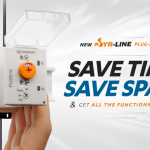M
otors are at the heart of any automated systems. When it comes to choose a motor, engineers have different possibilities. Depending on their applications (packaging, food and beverage, medical, infralogistics, agriculture,…), they need to meet a certain numbers of requirements (torque, speed, size, silent operation,…). Let’s consider DC motor more specifically here.
What is a DC motor?
DC motor is characterised by linear operating principles. These principles make the features of the motor easier to use than those of synchronous or asynchronous motors.
The DC motor -whether Brush or Brushless– is composed of three main components:
- A Brush DC motor contains:

- A stator made up of a metal enclosure surrounding attached magnets that create a permanent magnet field.
- An interior rotor, which is attached to the rotating output shaft. It has a metal structure supporting copper wire coils which, when energized, become electromagnets. Through the attraction of opposite magnetic poles and the repulsion of like poles a torque is created that turns the rotor.
- A commutator, which creates rotation by selectively energizing the rotor coils. Basically, a segmented copper assembly energizes the coils when it makes contact with a conductive carbon brush
- A Brushless DC motor contains:
- A fixed part, the stator, which has three groups of coils called the three phases of the motor. These coils operate as electromagnets and generate various orientations of magnetic field regularly distributed around the central shaft of the motor.
- A rotating part, the rotor, which has permanent magnets. Like the needle of a compass, these magnets permanently drive the rotor to try to align itself with the magnetic field of the stator. For optimum service life of the motor, the rotor is mounted on ball bearings.
- Three “Hall effect” magnetic sensors. These sensors provide information on the position of the rotor magnets at all times.
Operating principles
A DC motor converts a direct current into a mechanical work. As the principle of Lorentz Law puts it : “the current carrying conductor placed in a magnetic and electric field experience a force”.
No matter how complex the winding is, once it is suplied with power, it can be represented as a ferromagnetic cylinder with a solenoid at its edge. The wire of this solenoid is made up of the bundle of wire located in each slot of the rotor. The rotor then acts as an electromagnet. The direction of its magnetic induction is the axis separating the wires of the solenoid according to the direction of the current passing through them.
Therefore, the motor consists of fixed magnets, a moving magnet (the rotor) and a metal housing to concentrate the flux.
Attraction of the unlike poles and repulsion of the like poles generates a torque which is applied to the rotor, causing it to turn. This torque is at its maximum when the axis of the rotor poles is perpendicular to the axis of the stator poles.
Why choose a DC motor?
The efficiency of a motor is the ratio between the usable mechanical power that it can deliver and the electrical power that it absorbs. Since the usable and the absorbed powers vary differently with the speed of the motor, the efficiency also depends on the motor speed.
Many applications require a high starting torque. The DC motor, by its very nature, has a high torque vs. speed characteristic, enabling it to deal with high resistive torques and absorb sudden rises in load effortlessly. The motor speed adapts to the load. In addition, D.C motors are an ideal way of achieving the miniaturisation that is so desirable to designers, since they offer a high efficiency as compared with other technologies.
Wth a motor and control electronics, which can be used to control speed, forces and the direction of movement, to accelerate and decelerate, and count up and down the distance covered, it is easy to create automation systems.
Brushless DC motors incorporate CANopen technology to allow you to network several motors. This allows you to coordinate and synchronize every movement with high accuracy. Proven since 1980, the CANopen system ensures high reliability of data transmission through its error detection system.
With exceptional efficiency and working life, conformity to the strictest standards and wide range of available power supplies, Crouzet DCmind Brush Motors are ideal for use in medical equipments, pumps and valves, railways, and aeronautics.
DCmind Brushless motors, for their part, combine superb power density, integrated electronics and numerous functions for speed, torque and positioning control with absolute precision. This makes them ideal for applications in industry, valves and pumps, access control, robotics and the energy sector.



